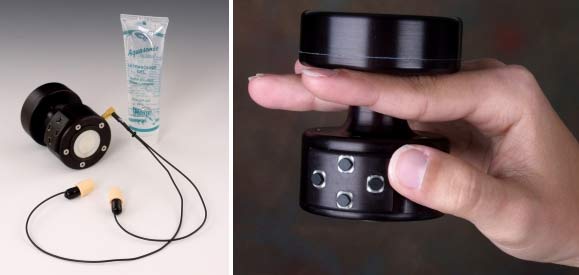New 'Quiet' Stethoscope Could Save Lives

A new "noise-immune" stethoscope could help doctors save lives on the battlefield, in disasters and in other noisy emergency situations.
Stethoscopes help doctors detect sounds in the body to investigate the condition of the heart, arteries, lungs and other organs after injuries or other maladies. The head of the conventional acoustic stethoscope conduct sounds as pressure waves up the stethoscope's hollow tubing to the listener's ears.
Noise from helicopters and other aircraft often used in medical evacuations from battlefields, train wrecks and other disasters make it hard to use stethoscopes. Sporting events, pop concerts and busy streets also make it difficult for physicians to listen through stethoscopes to properly diagnose and treat heart attack victims or other patients.
Noise can invade a conventional acoustic stethoscope at least three different ways—via the earpieces, tubing or head. They are usable up to about 80 to 85 decibels, about the volume of an alarm clock or a busy street.
Modern electronic stethoscopes are usable at 90 to 95 decibels, about the loudness of truck traffic or a subway train. Rather than conventional earpieces, these have insertable loudspeakers that do a better job of sealing off the ear canal from noise. They also replace the tubing with electrical cables that do not pick up acoustic noise. In addition, the design of the electronic head can minimize interference from airborne sound.
Still, background noise can infiltrate the electronic head of modern electronic stethoscopes, which means even they are not enough for brutally noisy emergencies. Noise levels can go as high as 120 decibels in a military helicopter like a Black Hawk or 100 decibels in indoor sports games or pop concerts.
Acoustical engineer Adrianus Houtsma at the U.S. Army Aeromedical Research Laboratory at Fort Rucker, Ala., and his colleagues have now designed a new stethoscope head that can generate ultrasound waves [image]. The resulting signals the stethoscope head picks up not only yield clues about the inner workings of the body, but are in sound frequencies that noise from helicopters, ambulances or crowds does not interfere with. They found it could operate even at 120 decibels.
Sign up for the Live Science daily newsletter now
Get the world’s most fascinating discoveries delivered straight to your inbox.
"This is likely to save many lives," Houtsma told LiveScience.
When in ultrasound mode, the new stethoscope hears the "lub dub" of a normal heartbeat as a "ta-da-da" pattern. Because of these and other significant differences from other stethoscopes in terms of sounds, to minimize confusion, the new stethoscope was designed to behave in standard electronic mode for quiet or moderately noisy environments and ultrasound mode in extreme noise conditions.
The scientists believe further research into the device could find specific sounds possibly linked to certain bodily anomalies, making their ultrasound stethoscope of use to cardiologists and other specialists. "Ultrasound audio images contain a lot more detail, but we do not know yet what these details may mean," Houtsma said.
Future work should focus on making sure the device is rugged enough for actual use. Researchers also have to make sure it does not generate emissions that interfere with aircraft or other equipment, and vice versa, Houtsma explained.
Houtsma and his colleagues will report their findings on Dec. 2 at a joint meeting of the Acoustical Society of America and the Acoustical Society of Japan in Honolulu.











